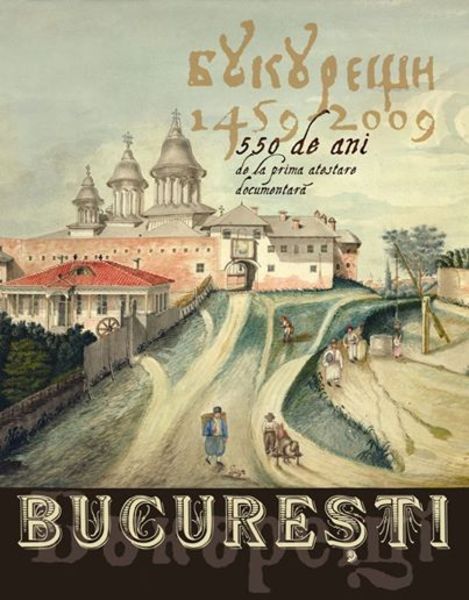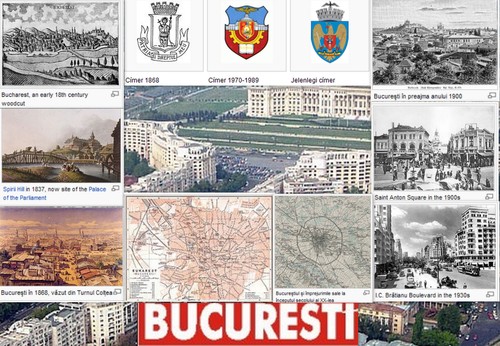

Alapítás: 1459. szeptember 21.
Legenda spune că Bucureștiul a fost fondat de un oier pe nume Bucur. Conform altei variante mai probabile, București a fost întemeiat de către Mircea cel Bătrân la sfârșit de secol XIV.
Pe malurile Dâmboviței și ale Colentinei este atestată cultura paleolitică și neolitică. Până în 1800 î. Hr. apar anumite dovezi ale unor comunități în zonele Dudești, Lacul Tei și Bucureștii-Noi de astăzi. Săpăturile arheologice arată trecerea acestei zone printr-un proces de dezvoltare din epoca bronzului și până în anul 100 î. Hr., în timpul căruia zonele Herăstrău, Radu Vodă, Lacul Tei, Pantelimon, dealul Mihai Vodă, Popești-Leordeni și Popești-Novaci sunt populate de indo-europeni (mai precis geto-daci). Primele locuințe după retragerea aureliană din 273 d. Hr. sunt atestate în secolele III - XIII, până în Evul Mediu.
Așezarea este atestată documentar la 21 septembrie 1459 într-un act emis de Vlad Țepeș, domn al Țării Românești, prin care se întărește o moșie unor boieri. Cetatea Dâmboviței, cum mai apare în primii ani orașul, avea rol strategic, urmând să supravegheze drumul ce mergea de la Târgșor la Giurgiu, în ultima așezare aflându-se o garnizoană otomană. În scurt timp, Bucureștiul se afirmă, fiind ales la 14 octombrie 1465 de către Radu cel Frumos ca reședință domnească. În anii 1558 - 1559, la Curtea Veche este construită Biserica Domnească, ctitorie a domnului Mircea Ciobanul, aceasta rămânând până astăzi cel mai vechi lăcaș de cult din oraș păstrat în forma sa inițială.
În 1659, sub domnia lui Gheorghe Ghica, Bucureștiul devine capitala Țării Românești, din ordin turcesc, pentru a avea o capitala in zona de campie si aproape de Dunare, mai usor de controlat in comparatie cu Targoviste. Din acel moment se si trece la modernizarea acestuia. Apar primele drumuri pavate cu piatră de râu (1661), se înființează prima instituție de învățământ superior, Academia Domnească (1694) și este construit Palatul Mogoșoaiei (Constantin Brâncoveanu, 1702), edificiu în care astăzi se află Muzeul de Artă Feudală Brâncovenească. În 1704, ia ființă la inițiativa spătarului Mihai Cantacuzino Spitalul Colțea, care a fost avariat ulterior într-un incendiu și un cutremur și reconstruit în 1888. În scurt timp, Bucureștiul se dezvoltă din punct de vedere economic; se remarcă creșterea numărului meșteșugarilor, ce formau mai multe bresle (ale croitorilor, cizmarilor, cavafilor, cojocarilor, pânzarilor, șalvaragiilor, zăbunarilor ș.a). Odată cu acestea continuă modernizarea orașului. Sunt create primele manufacturi și cișmele publice, iar populația se mărește continuu prin aducerea de locuitori din întreaga Muntenie (catagrafiatul din 1798 indica 30.030 de locuitori, în timp ce cel din 1831 număra 10.000 de case și 60.587 de locuitori).
------------------------------------------------------------------------------------------------------------------------------------------------
Bucharest's history alternated periods of development and decline from the early settlements of the Antiquity and until its consolidation as capital of Romania late in the 19th century.
First mentioned as the "Citadel of București" in 1459, it became a residence of the Wallachian prince Vlad III the Impaler. The Old Princely Court (Curtea Veche) was built by Mircea Ciobanul, and under subsequent rulers, Bucharest was established as the summer residence of the court, competing with Târgoviște for the status of capital after an increase in the importance of southern Muntenia brought about by the demands of the suzerain power, the Ottoman Empire.
Bucharest, an early 18th century woodcut
Burned down by the Ottomans and briefly discarded by princes at the start of the 17th century, Bucharest was rebuilt and continued to grow in size and prosperity. Its centre was developed around the Ulița Mare (lit. Grand Street), which starting with 1589 became known as Lipscani. Before the 18th century, it became the most important trade centre of Wallachia and became a permanent location for the Wallachian court after 1698 (starting with the reign of Constantin Brâncoveanu).
Partly destroyed by natural disasters and rebuilt several times during the following 200 years[clarification needed], and hit by Caragea's plague in 1813–1814, the city was wrested from Ottoman control and occupied at several intervals by the Habsburg Monarchy (1716, 1737, 1789) and Imperial Russia (three times between 1768 and 1806). It was placed under Russian administration between 1828 and the Crimean War, with an interlude during the Bucharest-centred 1848 Wallachian revolution, and an Austrian garrison took possession after the Russian departure (remaining in the city until March 1857). Additionally, on 23 March 1847, a fire consumed about 2,000 buildings, destroying a third of the city.
Saint Anton Square in the 1900s (decade)
In 1862, after Wallachia and Moldavia were united to form the Principality of Romania, Bucharest became the new nation's capital; in 1881, it became the political centre of the newly-proclaimed Kingdom of Romania under Carol I. During the second half of the 19th century, due to its new status, the city's population increased dramatically, and a new period of urban development began. During this period, gas lighting, horse-drawn trams and limited electrification were introduced.[17] The Dâmboviţa was also chanelled in 1883, thus putting a stop tgo previously endemic floods.[18] The extravagant architecture and cosmopolitan high culture of this period won Bucharest the nickname of "The Paris of the East" (or "Little Paris", Micul Paris), with Calea Victoriei as its Champs-Élysées.
I.C. Brătianu Boulevard in the 1930s
Aerial view of the city in 1916
Between 6 December 1916 and November 1918, the city was occupied by German forces as a result of the Battle of Bucharest, with the legitimate capital temporarily moved to Iași. After World War I, Bucharest became the capital of Greater Romania. The interwar years saw continued development, with the city gaining an average of 30,000 new residents each year. Also, some of the city's main landmarks were built in this period, including Arcul de Triumf and Palatul Telefoanelor.[19] However, the Great Depression took its toll on Bucharest's citizens, culminating in the Griviţa Strike of 1933.[20]
In January 1941, the city was the scene of the Legionnaires' rebellion and Bucharest pogrom. As the capital of an Axis country and a major transit point for Axis troops en route to the Eastern Front, Bucharest suffered heavy damage during World War II due to Allied bombings, and, on 23 August 1944, was the site of the royal coup which brought Romania into the Allied camp, suffering a short period of Luftwaffe bombings as well as a failed attempt by German troops to take the city by force.
After the establishment of communism in Romania, the city continued growing. New districts were constructed, most of them dominated by tower blocks. During Nicolae Ceaușescu's leadership (1965–1989), much of the historic part of the city was demolished and replaced with Socialist realist development such as the Centrul Civic (the Civic Centre), including the Palace of the Parliament, where an entire historic quarter was razed to make way for Ceaușescu's megalomaniac constructions. On 4 March 1977, an earthquake centered in Vrancea, about 135 km (83.89 mi) away, claimed 1,500 lives and caused further damage to the historic centre.
The Romanian Revolution of 1989 began with mass anti-Ceaușescu protests in Timișoara in December 1989 and continued in Bucharest, leading to the overthrow of the Communist regime. Dissatisfied with the post-revolutionary leadership of the National Salvation Front, student leagues and opposition groups organized large-scale protests continued in 1990 (the Golaniad), which were violently stopped by the miners of Valea Jiului (the Mineriad). Several other Mineriads followed, the results of which included a government change.
After the year 2000, due to the advent of significant economic growth in Romania, the city has modernized and is currently undergoing a period of urban renewal. Various residential and commercial developments are underway, particularly in the northern districts, while Bucharest's historic centre is currently undergoing restoration.
---------------------------------------------------------------------------------------------------------------------------------------------
legenda szerint Bukarestet egy Bucur nevű pásztor alapította. Ezt a legendát először 1761-ben egy ferences szerzetes, Blasius Kleiner jegyezte fel. A történet szerint a pásztor egy templomot emelt, amely napjainkban is nevét viseli, de a vizsgálatok kimutatták, hogy a templom csak 1743 körül épült. A legenda alapját az képezi, hogy Bukarest román nevének (București) elemei a román „bucurie” (boldogság) és "-esti" (településnév-képző, az -escutöbbesszáma) szavak. Egy másik legenda szerint a várost Negru Vodă alapította. Erről a legendáról először a raguzai Giacomo di Pietro Luccari tesz említést, aki Vitéz Mihály uralkodása alatt járta be Havasalföldet és állított össze egy részletes monográfiát az országról.[2]
Hivatalos dokumentumok először 1459. szeptember 20-án említik, nevezetesen egy Vlad Țepes fejedelem által aláírt dokumentum erősít meg javaiban egy bukaresti gazdát. Egy 1460-ból származó fejedelmi dokumentum castro fluvii Dombovicha néven említi, míg 1461-ben castro Bokoresth néven szerepel.[3]
Mircea Ciobanu megrendelésére 1558 és 1559 között újjáépült a Curtea Veche (Régi Fejedelmi Udvar) és megépült a Biserica Domnească (Fejedelmi Templom), Bukarest első jelentősebb építményei. Mindkettő számottevően megrongálódott a XVII.-XVIII. századi törökjárások, földrengések, tűzvészek során; az udvar romjaiban jelenleg múzeum működik, a templomot többször újjáépítették és jelenleg a város legrégebbi épületeként tartják számon.
Fővárosként először 1659-ben említik, Gheorghe Ghica uralkodása alatt, ekkor kezdődik a város igazi fejlődése. Megjelentek az első kövezett utak (1661), megalapították az első felsőoktatási intézményt, az Academia Domnească-t (Fejedelmi Iskola, 1694) és felépült a Mogoșoaia-palota (1698), ahol ma a Brâncoveanu-múzeum található.
Mihai Cantacuzino támogatásával 1704-ben megépült a Colțea kórház. Rövid időn belül Bukarestet is ellepik a mesterek, létrejönnek az első céhek. Míg 1798-ban még csak 30 030 lakost számláltak, 1831-ben ez a szám megduplázódott. Megjelennek az első közérdekű építmények, mint a Nemzeti Színház és a Cișmigiu Park. A város 1862-ben vált az 1859-ben egyesített Románia fővárosává.[4]
Miután 1916 augusztusában Románia hadat üzent a központi hatalmaknak. 1918 tavaszán Románia különbékét kért, és kötött. A második világháborúban a város nem került ostrom alá, így kevesebbet szenvedett, a szovjet csapatok a román átállás miatt ellenállás nélkül szállhatták meg.
1956 novemberében a diákok kommunizmus-ellenes megmozdulásokat szerveztek, de a katonaság leverte és megtorolta az akciót. 1989 decemberében megdöntötték Ceaușescut .
Alapítás: 1459. szeptember 21.
Alapítás: 1459. szeptember 21.






Kapcsolódó hírek:
Bucureşti vasúti megközelítése .
Bucureşti - i légi megközelítése , légikikötői,légitásaságai
Metroul Bucureşti - Bucharest City Subway- Bukaresti Metro
Bucureşti viitor - Bucharest's future - Bukarest jövője. Több mint izgalmas , kirobbanóan fiatalos !